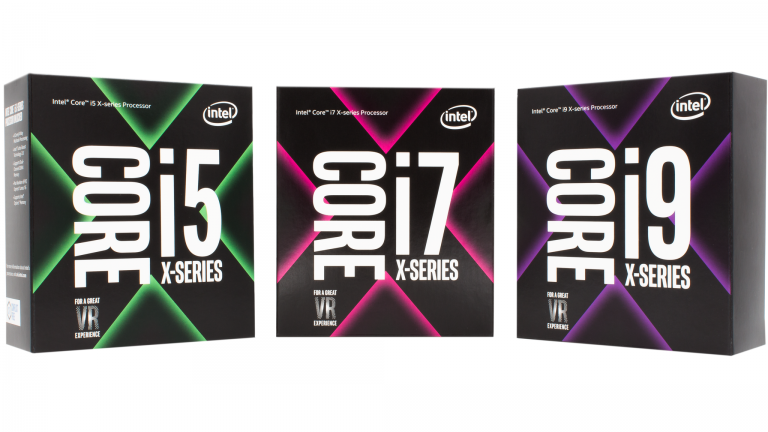Last month during Computex, Intel officially unveiled its new Core-X lineup and while most of those new CPUs are already on the market, there are still four Core i9 SKUs we have yet to see. Intel still has a few more SKUs up its sleeve, with 12C/24T, 14C/28T, 16C/32T and a 18C/36T Core i9 all on the way. We don't know a ton about these higher core count CPUs yet but today, some news broke about the 12-core 7920X, indicating that Intel is struggling with clock speeds, particularly compared to AMD's Threadripper CPUs.
Intel's 12C/24T Core i9 7920X will apparently run with a base frequency of just 2.9GHz, which is 400MHz lower than the 10-core 7900X. Perhaps more interestingly, it is 600MHz lower than AMD's competing 12-core Ryzen Threadripper 1920X, which has a base speed of 3.5GHz.
This new information comes our way via Videocardz, showing the Core i9-7920X with 12 cores, 24 threads, a 2.90GHz base clock speed and a $1,189 price tag. No other specs were listed beyond that, though we do know that this chip will come with a sizeable 16.5MB of L3 cache.
KitGuru Says: CPU clock frequencies aren't everything when it comes to measuring speed, IPC will also play a big role. Still, this news does make things very interesting. I'll be looking forward to seeing comparisons between Threadripper and Intel's new higher core count X299 chips.
 KitGuru KitGuru.net – Tech News | Hardware News | Hardware Reviews | IOS | Mobile | Gaming | Graphics Cards
KitGuru KitGuru.net – Tech News | Hardware News | Hardware Reviews | IOS | Mobile | Gaming | Graphics Cards




and there we go … by the time we get to the even higher core counts, we’ll find out the 16 core runs at 2.4Ghz base clock and the 18 core at 2.0Ghz. In the mean time, AMD happily chugs along with threadripper, putting out way faster chips at lower prices. If AMD is glued-together crap (as on the intel slides), then what is this intel stuff really?
My first thought is that motherboards using a single EPS12v 8-pin connection are already seeing the limit of their output on the 10c units (and when OC’ing, they appear to be getting dangerously hot in certain situations, especially those psus utilizing a universal output connection from the psu i/o panel like many of the superflower platinum psus), and since intel were the ones to provide mobo makers with the chip requirements, it’s safe to assume they’ve tailored their entire SK-X line on only needing that single connector, and not 8+4 or 8+8 as seen on higher end boards.
The extra cores and cache on the higher tier chips, paired with the baseline limited power delivery will likely mean a pretty nasty drop-off in clock speed for the 12-18c chips. I’d not be surprised to see the 18c with a ~2.4ghz base clock in order to meet the restrictions imposed by that single 8 pin connection, though dual core boost / turboboost 3 will likely still remain in the 4-4.5ghz range.
AMD’s approach just means more yield, and chances that each die could reach a rated frequency. Intel’s approach is “spared no expense” in terms of latency and bandwidth, but at the cost of not getting the best yield for higher frequencies for larger core count dies.
It’s just the nature of things, it would have been diminishing returns if AMD choose too small a die/core count versus the bottlenecks.
Shame they couldn’t apply that “spare no expense” attitude to their IHS.
Well, only the client side gets the paste, and it isn’t like any Intel user will leave Intel because of it.
There are pros and cons with each approach, I wonder which one will prove to be the most effective. Maybe AMD sacrificed inter-CCX and inter-die latency and gained on almost everything else : their 2-die and 4-die parts are more friendly to higher clocks, since the dies are distinct, and the heat of one does not directly affect the other (provided there is excellent cooling to dissipate the heat away, ideally water-cooling).
AMD has higher yields, thus lower costs, thus (potentially) higher profit margins – in high core Epyc parts anyway. Intel’s addition of AVX-512 drastically underclocks their CPUs when in use, while raising the TDPs further. Intel’s more mature manufacturing process allows them to overclock their CPUs further, the ones up to 8 or 10 cores anyway (for the 12+ cores only with LN2 presumably).
AMD has better, sometimes much better performance/price from top to bottom. Intel has a gain on games.